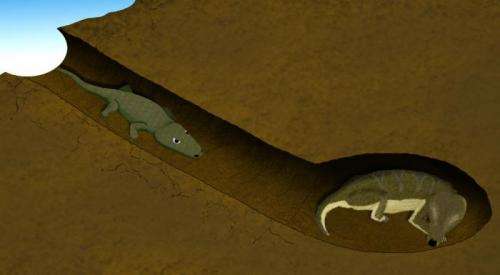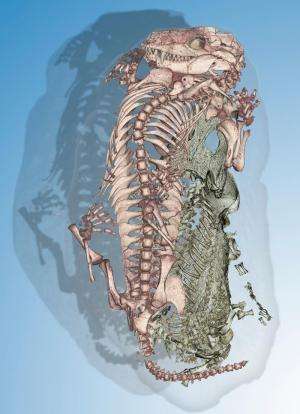Anthropologists help solve mystery of 250 million-year-old strange bedfellows

(Phys.org) —They were strange bedfellows in a 250 million-year-old burrow: the sleeping, cat-size mammal forerunner Thrinaxodon liorhinus and the slightly smaller amphibian Broomistega putterilli that crawled in after, suffering from labored breathing caused by fractures on seven ribs.
An international team of scientists that includes two Indiana University anthropologists said the unique mixed-species association ended abruptly when a tidal rush of wet sand entombed the two in South Africa's Karoo region shortly after the geologic event known as the Great Dying. The team also confirmed the first fossil evidence of any species of the rare amphibian's order (Temnospondyli) to be found in a burrow.
Mammal-like and carnivorous, T. liorhinus was the initial resident of the burrow. It was likely aestivating—in a self-induced state of torpor used by mammals to survive hot, dry environments—when B. putterilli visited in search of a protective retreat after having suffered a single, crushing blow to the thorax. For brevity, the researchers identify the two in conversation as "Broom" and "Thrin."
"Half the ribs on one of the Broom's ribcage were broken and in various stages of healing," IU anthropology professor Della Collins Cook said. "Breathing and walking would have been painful, and the Broom must have lived with these injuries for several weeks."
Collaborating with the European Synchrotron Radiation Facility in Grenoble, France, the team transported the burrow cast, which had resided at the University of the Witwatersrand since its collection in 1975, to Grenoble for scanning. After reconstructing digital images, they were able to determine the general health and age of the two animals, their exact positions in the burrow, and the influences that several flooding events had on their condition.

A synchrotron uses magnetic fields to bend accelerated electron beams and convert high-energy electron energy into bright X-ray radiation. It is useful in fields as diverse as earth science, paleontology, chemistry and protein crystallography. In this case, the researchers were able to scan the large fossilized burrow cast in a nondestructive way, unveiling the rare example of cohabitation by two different animals within the very sediments in which they were entombed.
"Recent developments in synchrotron imaging are offering new opportunities to visualize burrow contents that facilitate a more thorough understanding of the lifestyle of ancient organisms, including therapsids, and specifically cynodonts such as Thrin that eventually gave rise to mammals," said Kristian J. Carlson, a senior researcher and research associate in the IU Bloomington College of Arts and Sciences' Department of Anthropology.
"Cohabitation by different species is difficult to interpret, particularly in the fossil record when behavioral information of the host and the intruder are not directly observable," he added.
In this case, the researchers surmise, T. liorhinus—"Thrin"—may have tolerated the arrival of the injured amphibian because of its semi-conscious state during active aestivation.
The team noted no evidence of T. liorhinus having attacked the amphibian. Based on modern comparative examples of cohabitation, the profile of these two types of animals was not consistent with conscious toleration by the host Thrin.
Either way, the two died either slightly before or during a rapid flooding event that quickly deposited a layer of sand that encased and nearly covered them sometime after the Permian-Triassic extinction (the Great Dying) when 9 of 10 marine species and 7 of 10 land species vanished from the planet.
Lead author on the paper with Carlson and Cook was Vincent Fernandez of Witwatersrand. Additional co-authors were Fernando Abdala, Bruce S. Rubidge and Adam Yates, all also of Witwatersrand, and Paul Tafforeau of the European Synchrotron Radiation Facility. Carlson is also affiliated with Witwatersrand, Fernandez with the ESRF, and Yates with the Museum of Central Australia in Alice Springs, Australia.
Carlson, who received his M.A. and Ph.D. in anthropology at IU Bloomington, made international news in 2010 as part of a Witwatersrand-based team of scientists that announced discovery of a new species of fossil hominin, Australopithecus sediba, which was suggested to be ancestral to genus Homo. He then led research more closely examining brain development in the 2 million-year-old hominin.
Provided by Indiana University




















